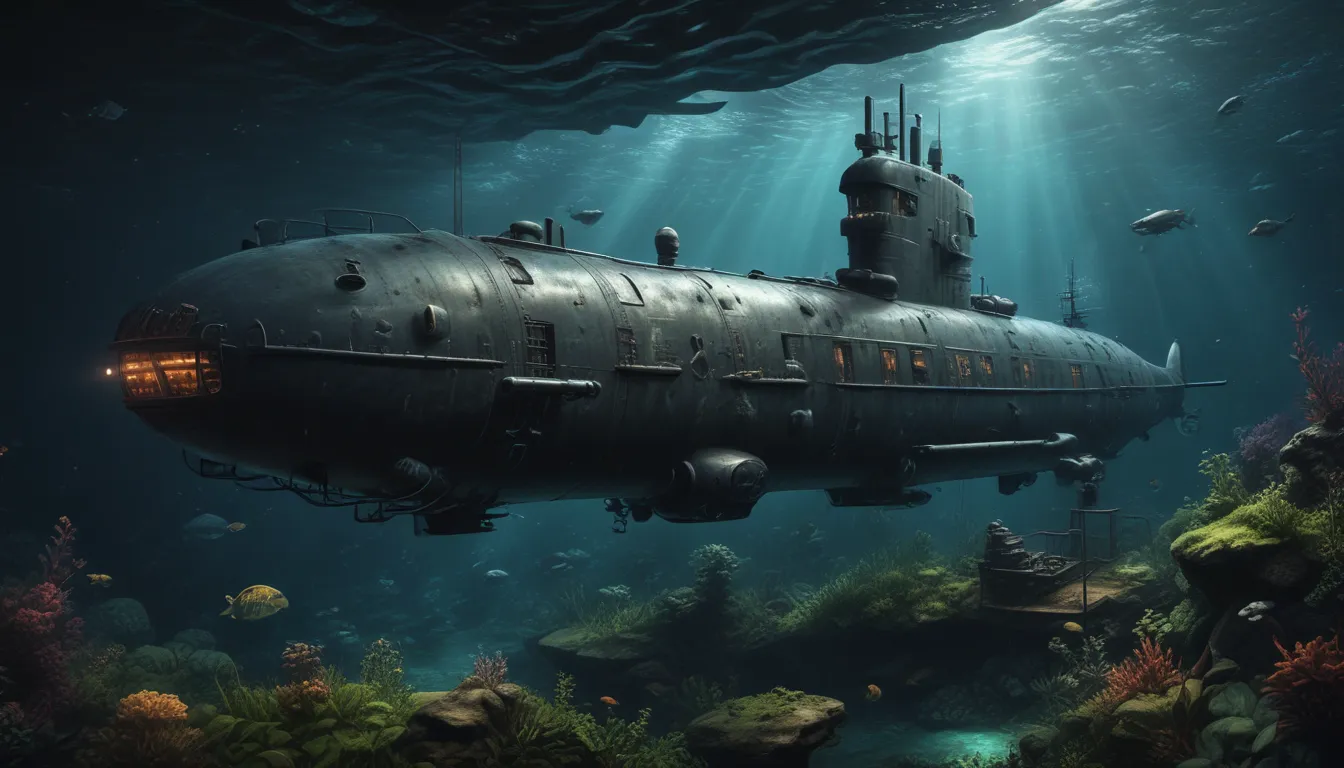A Note About Images: The images used in our articles are for illustration purposes only and may not exactly match the content. They are meant to engage readers, but the text should be relied upon for accurate information.
Submarines have always held a special place in the hearts and minds of people worldwide. These remarkable vessels represent a perfect blend of cutting-edge technology and daring exploration, with a rich history that dates back to the 17th century. Whether you’re a technology enthusiast, a history buff, or simply curious about the mysteries that lie beneath the waves, submarines are sure to captivate your imagination. In this article, we’ll dive deep into the world of submarines, uncovering 20 captivating facts that shed light on their incredible capabilities, historical significance, and ongoing evolution. So, get ready for an exhilarating journey into the depths of submarine exploration!
Unlocking the Secrets of Submarines
The Genesis of Submarines: A Historical Perspective
The first submarine in recorded history was built in 1620 by Cornelius Drebbel, showcasing remarkable engineering prowess for its time. Known as the “Drebbel,” this early submarine utilized oars for propulsion, laying the foundation for future advancements in underwater navigation.
Speed Demons of the Sea: Submarines in Motion
Submarines are renowned for their impressive speed capabilities, with modern nuclear-powered submarines reaching speeds of up to 40 knots (46 mph). This exceptional velocity allows submarines to swiftly maneuver through the ocean depths, highlighting the advanced engineering and propulsion systems at play.
The Turtle: Pioneering Underwater Warfare
During the American Revolutionary War, the Turtle made waves as the first combat submarine, designed by David Bushnell. Hand-powered and featuring a unique egg-shaped structure, the Turtle showcased early innovations in submarine warfare technology.
A Crucial Role in History: Submarines in World War II
Submarines emerged as pivotal assets during World War II, with both Allied and Axis powers utilizing these vessels for reconnaissance, blockades, and strategic attacks. The ability to operate covertly beneath the ocean’s surface significantly influenced the outcome of naval warfare.
Nuclear Revolution: The Birth of USS Nautilus
In 1954, the USS Nautilus made history as the world’s first operational nuclear-powered submarine. This groundbreaking achievement revolutionized underwater navigation, providing submarines with extended range, increased speed, and prolonged operational capabilities.
Echolocation of the Sea: Sonar for Navigation
Submarines rely on sonar, or “sound navigation and ranging,” to navigate and detect objects underwater. By emitting sound pulses and analyzing echoes, submarines can effectively traverse the ocean depths and identify potential obstacles or targets.
The Art of Stealth: Cloaking Technology on Submarines
Stealth technology is integral to submarine design, allowing these vessels to operate covertly and evade detection by enemy forces. Specialized coatings, sound-dampening measures, and streamlined profiles minimize acoustic and visual signatures, enhancing operational effectiveness.
Surviving the Abyss: Submarines and Water Pressure
Submarines are engineered to withstand immense water pressure experienced at significant oceanic depths. Through robust construction and materials, submarines can navigate varying depths while ensuring the safety and security of the crew and equipment onboard.
The Silent Guardians: Submarines in National Defense
Submarines play a vital role in national defense and maritime security, contributing to deterrence strategies and safeguarding oceanic territories. Their strategic capabilities and operational versatility make them indispensable assets for upholding national security initiatives.
The Submarine Symphony: Advanced Communication Systems
Secure communication systems are essential for submarines to maintain contact with command authorities and relay critical information while submerged. Advanced encryption and transmission technologies ensure secure and reliable communications, enhancing operational efficiency and confidentiality.
Oceanic Explorers: Submarines in Scientific Research
Beyond military applications, submarines are crucial for scientific research and ocean exploration. Equipped with advanced instrumentation, submersibles enable scientists and researchers to study marine ecosystems, geological formations, and underwater phenomena, deepening our understanding of the ocean environment.
Crew Dynamics and Operational Excellence
The Unsung Heroes: Diverse Crew of Submarines
A submarine’s crew comprises skilled submariners responsible for operating the vessel and executing mission objectives, alongside support personnel providing essential services, maintenance, and logistical support. This collaborative team dynamic is essential for successful submarine operations.
Training Excellence: Rigorous Certification Processes
Submarine crews undergo intensive training and certification processes to ensure proficiency in operating and maintaining these complex vessels. From simulated emergency drills to specialized technical training, submariners are equipped with the skills and knowledge necessary for effective operations.
Sustaining the Crew: Galley Facilities on Submarines
To sustain crew members during extended missions, submarines are equipped with dedicated galley facilities where meals are prepared and served. These facilities are essential for maintaining crew morale and well-being while at sea, showcasing the focus on crew support within submarine operations.
Emergency Preparedness and Strategic Capabilities
Seconds to Surface: Emergency Procedures for Submarines
In emergency situations, submarines are equipped with rapid surfacing procedures to facilitate a swift ascent to the ocean’s surface. These procedures are crucial for addressing critical situations and ensuring the safety of the crew in challenging underwater conditions.
Covert Deployments: Special Operations Forces from Submarines
Submarines serve as platforms for covertly deploying special operations forces, enabling stealthy insertion and extraction of personnel for strategic missions. This capability enhances the versatility and effectiveness of submarines in supporting special operations objectives.
Extended Endurance: Nuclear Reactors Powering Submarines
Nuclear-powered submarines harness the energy generated by onboard nuclear reactors to propel the vessel and support its systems. This self-sustaining power source provides submarines with extended operational range and endurance, enabling them to undertake prolonged missions without frequent refueling.
Beneath the Waves: Submarines Staying Submerged
Modern submarines are equipped with advanced life support systems and provisions enabling them to remain submerged for extended periods, ranging from weeks to months. This prolonged submerged capability enhances stealth and strategic effectiveness during missions and operations.
Oceanic Sentinels: Surveillance Capabilities of Submarines
Submarines can launch ballistic missiles from underwater positions, enhancing deterrence and defense capabilities. Nuclear-powered submarines like the Ohio-class possess the capability to launch intercontinental ballistic missiles (ICBMs), contributing to global security initiatives.
Concluding Thoughts on Submarines
Submarines continue to enchant and inspire with their technological prowess, operational excellence, and strategic significance. From historical milestones to cutting-edge capabilities, submarines represent a testament to human ingenuity and maritime excellence. The allure of these underwater vessels resonates through the ages, capturing the imagination of generations to come as they explore the depths of the ocean. With a blend of history, innovation, and exploration, submarines truly embody the spirit of adventure and curiosity that drives human progress.
Unveiling the Mysteries: 20 Submarine Fun Facts to Inspire and Educate
Submarines have long been a source of fascination and intrigue for people around the world, embodying a unique blend of technology, exploration, and strategic importance. From their historical origins to their modern capabilities, submarines continue to captivate imaginations and inspire wonder. In this article, we will delve into the depths of submarine exploration, uncovering 20 fascinating facts that shed light on their extraordinary feats and enduring allure. Whether you are a history enthusiast, a science buff, or simply curious about the world beneath the waves, these fun facts are sure to expand your knowledge and appreciation of these remarkable vessels.
Key Takeaways:
- Submarines have a rich history dating back to the 17th century, showcasing remarkable engineering and propulsion systems for underwater navigation.
- Submarines play a crucial role in national defense and maritime security, with advanced technology and stealth capabilities for strategic operations.
Exploring the Origins: From Drebbel to Nuclear-Powered Submarines
The Birth of Submarines: The Drebbel Era
The first recorded submarine, the “Drebbel,” was constructed in 1620 by Dutch inventor Cornelius Drebbel, demonstrating early advancements in underwater navigation. This remarkable feat of engineering laid the groundwork for future submarines and underwater exploration.
Speeding Through the Depths: Submarines at 40 Knots
Modern submarines can travel at speeds of up to 40 knots, showcasing impressive engineering and propulsion systems. This exceptional velocity allows submarines to maneuver swiftly through the ocean, highlighting their advanced capabilities for underwater navigation.
The Turtle’s Legacy: Combat Submarines in History
During the American Revolutionary War, the Turtle emerged as the first successful combat submarine, designed by David Bushnell. Hand-powered and featuring a unique egg-shaped structure, the Turtle introduced early innovations in underwater warfare technology.
World War II: Submarines in Naval Warfare
Submarines played a pivotal role in World War II, serving as crucial assets for reconnaissance, blockades, and strategic attacks. The ability to operate covertly beneath the ocean’s surface significantly influenced the outcome of naval warfare during the war.
Nuclear Power Revolution: USS Nautilus Sets Sail
The USS Nautilus made history in 1954 as the world’s first operational nuclear-powered submarine, revolutionizing underwater navigation. Nuclear propulsion provided submarines with extended range, increased speed, and prolonged operational capabilities, marking a significant milestone in maritime technology.
Navigating the Depths: Technology and Capabilities
Echoes of the Sea: Sonar for Submarine Navigation
Submarines utilize sonar technology for underwater navigation and object detection, emitting sound pulses to analyze echoes. This critical technology enables submarines to navigate through the ocean depths and identify potential obstacles or targets.
Submerged Warriors: Extended Endurance and Stealth
Modern submarines can remain submerged for months at a time, equipped with advanced life support systems. This capability enhances their stealth and strategic effectiveness during missions, showcasing the operational prowess of submarines beneath the waves.
Weathering the Storm: Submarines and Water Pressure
Submarines are designed to withstand immense water pressure experienced at significant depths in the ocean. Through robust construction and materials, submarines can navigate varying depths while ensuring the safety of the crew and equipment onboard.
Strategic Deterrence: Ballistic Missile Capabilities
Nuclear-powered submarines like the Ohio-class can launch intercontinental ballistic missiles (ICBMs) from underwater positions. This strategic capability enhances deterrence and defense capabilities, contributing to global security initiatives.
Stealth Guardians: Advanced Covert Technologies
Stealth technology is integral to submarine design, allowing vessels to operate covertly and evade enemy detection. Submarines employ specialized coatings, sound-dampening measures, and streamlined profiles to minimize acoustic and visual signatures, enhancing their strategic effectiveness.
Responding to Emergencies: Safety and Rescue Systems
Safety First: Submarine Emergency Rescue Systems
Specialized rescue systems like the Submarine Rescue Diving and Recompression System (SRDRS) are deployed in emergencies to extract crew members from distressed submarines. These advanced rescue capabilities highlight the commitment to crew safety within submarine operations.
Beyond Warfare: Submarines in Scientific Exploration
Submarines play a crucial role in scientific research and ocean exploration, equipped with advanced instrumentation. Scientists utilize submersibles to study marine ecosystems, geological formations, and underwater phenomena, expanding our understanding of the ocean environment.
Team Dynamics: The Crew of Submarines
A submarine’s crew consists of skilled submariners operating the vessel and support personnel providing essential services. This collaborative team dynamic is essential for successful submarine operations, showcasing the dedication and expertise of submarine crews.
Training Excellence: Rigorous Certification for Submarine Crews
Submarine crews undergo intensive training and certification processes to ensure proficiency in operating and maintaining these complex vessels. From emergency drills to technical training, submariners are equipped with the necessary skills for effective operations.
Communication and Connectivity: Enabling Operations
Secure Transmission: Advanced Communication Systems
Secure communication systems are vital for submarines to relay critical information while submerged. Advanced encryption and transmission technologies ensure secure and reliable communications, enhancing operational efficiency and confidentiality.
Powering the Depths: Nuclear Reactors on Submarines
Nuclear-powered submarines utilize onboard nuclear reactors to propel the vessel and support its systems. This self-sustaining power source enables submarines to undertake prolonged missions without frequent refueling, enhancing their operational capabilities.
Dining Beneath the Waves: Galley Facilities on Submarines
Dedicated galley facilities on submarines provide crew members with meals during extended missions. These facilities are essential for maintaining crew morale and well-being, showcasing the commitment to crew support within submarine operations.
Covert Insertion: Deploying Special Operations Forces
Submarines serve as platforms for covertly deploying special operations forces, enabling stealthy insertion and extraction of personnel for strategic missions. This capability enhances the versatility and effectiveness of submarines in supporting special operations objectives.
Emergency Surfaces: Rapid Ascent Procedures
In emergency situations, submarines are equipped with rapid surfacing procedures for swift ascents to the ocean’s surface. These procedures are crucial for addressing critical situations and ensuring the safety of the crew in challenging underwater conditions.
Safeguarding Sovereignty: National Defense and Maritime Security
Submarines play a crucial role in safeguarding national interests and maritime security, contributing to deterrence strategies. Their strategic capabilities and operational versatility make them indispensable assets in upholding national defense initiatives.
Journey Through the Ocean: A Conclusion
As we conclude our exploration of submarines, it is evident that these remarkable vessels embody a blend of history, innovation, and strategic significance. From their pioneering origins to their pivotal role in modern naval operations, submarines continue to captivate and inspire with their technological prowess and operational excellence. The “20 Submarine Fun Facts” offer a glimpse into the captivating realm of underwater exploration and defense, showcasing the remarkable feats achieved within the domain of submarine technology and operations. Whether delving into historical milestones or unveiling the advanced capabilities of modern submarines, the allure of these underwater vessels persists as a testament to human ingenuity and maritime excellence.
Frequently Asked Questions (FAQs)
-
What is the history of submarines?
Submarines have a rich history dating back to the 17th century, with various inventors and engineers contributing to their evolution. The first documented military use of a submarine was during the American Revolutionary War, showcasing the early potential of underwater vessels. -
How do submarines submerge and resurface?
Submarines use ballast tanks to control their buoyancy. By adjusting the amount of water in these tanks, the submarine can either submerge or surface. Filling the tanks with water causes the submarine to descend, while expelling water allows it to rise to the surface.
Unveiling a World of Wonder
Submarines are not just vessels; they are symbols of human ingenuity, exploration, and strategic prowess. From historical milestones to modern capabilities, submarines continue to fascinate and inspire. As we journey through the depths of the ocean, the allure of these incredible machines will undoubtedly continue to captivate and inspire awe and wonder for generations to come. Dive deep into the world of submarines, unlock the mysteries of the sea, and embark on an adventure of discovery and exploration beneath the waves.






